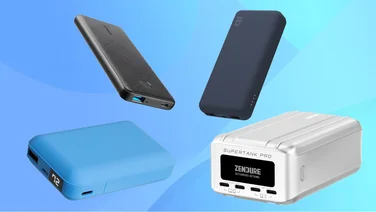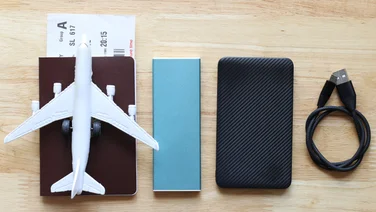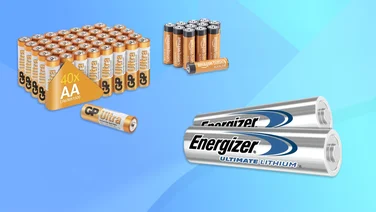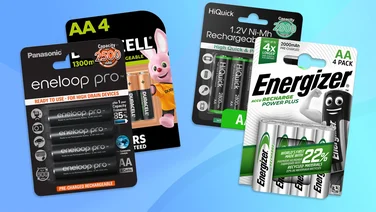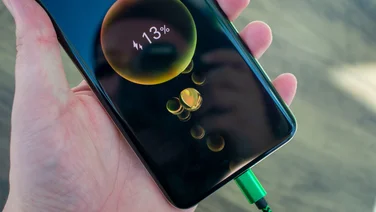To help us provide you with free impartial advice, we may earn a commission if you buy through links on our site. Learn more
- Best solar power banks and chargers: At a glance
- How to choose the best solar charger or power bank for you
- How we test solar power banks and chargers
- The best solar power banks and chargers you can buy in 2024
- 1. Swarey Solar Charger 30W: Best budget solar charger
- 2. Bluetti EB55: Best compact solar generator
- 3. Anker PowerHouse 767: Best heavy-duty solar generator for camping, caravanning and home
- 4. UGreen PowerRoam 1200W: Best compact power station for performance
- 5. Jackery Explorer 1500 Pro: Best solar generator for power and portability
- 6. A Addtop Solar Charger Power Bank 25000mAh: Best compact solar power bank
- 7. BigBlue 28W Solar Charger: Best solar charger for reliable power

Heading off-grid for the weekend? Whether it’s hiking in the hills, or having fun at a festival, a solar charger or a power bank could be just what you need to keep your devices topped up.
By miniaturising solar panels, and making them more portable, you can charge your smartphone, tablet or even laptop using free energy directly from the sun – or, in some cases, you can even store that energy for later use. In theory, you can be away from the mains for days and still keep your devices powered up. You might even find that, weather permitting, you can keep a laptop or a tablet charged up using solar energy alone.
With various types of solar chargers and power banks available, coming in at a range of different prices, we’ve made the task of choosing the right device for you simple. Read our guide to learn more about such devices, and then on to discover our pick of the best solar chargers and power banks available.
Best solar power banks and chargers: At a glance
- Best budget solar charger: Swarey Solar Charger 30W | £60
- Best for power and portability: Jackery Explorer 1500 Pro | £1,499
- Best compact solar generator: Bluetti EB55 | From £569
- Best compact solar power bank: A Addtop Solar Charger Power Bank 25000mAh | £51
How to choose the best solar charger or power bank for you
What are the different types available?
Solar chargers and power banks come in three basic types:
- Solar generators – One or more large, folding solar panel arrays are hooked up to a unit containing a heavy-duty lithium-ion battery alongside at least one three-pin mains socket and a range of USB ports. Provided the solar panels can gather enough sunlight during daylight hours, you should have sufficient stored energy to charge or power a wide range of devices, from smartphone and laptops up to projectors and even TVs.
- Solar chargers – These take the same basic idea of a solar generator but shrink the solar panel array to make it more portable. They charge your devices directly or through a separate USB power bank.
- Solar power banks – Combining an even smaller solar array with a USB power bank in one neat unit, keeping a solar power bank charging during the day will enable you to recharge your smartphone or tablet overnight.
Which are the most effective?
The big solar generators are the most effective, but they’re expensive and only really portable if you have a car in which to transport them. The generator unit alone can weigh anywhere between 6kg and 20kg, while the solar panels may be around 50 x 50cm when folded and weigh upwards of another 6kg. You probably won’t want that while you’re hiking.
With the smaller solar chargers and power banks, you need to be realistic. Although solar panel technology is evolving all the time, most solar cells are only between 15% and 25% efficient when converting the sun’s energy into output, and that means you need a lot of surface area to get decent results. While some manufacturers sell solar power banks where the top of the power bank is packed with solar cells, these won’t harvest enough energy in an average UK day to charge the power bank up by any significant amount. Even with the large fold-out solar chargers, you might struggle to get the rated output outside of the brightest, clearest days.
What inputs and outputs should you look for?
The big solar generators will have multiple USB outputs alongside at least one mains output and/or 12V output for car accessories. The solar chargers and power banks will have one or two 5W or 10W USB Type-A outputs. Often, at least one USB port will support faster charging through Qualcomm QuickCharge 3.0 (up to 36W) or USB PD (up to 100W).
Solar generators and power banks will also have a mains or USB input, enabling them to be charged in a few hours before you head off on a trip. This is especially important with power banks, since they work better if you give them a charge to begin with, then use solar energy for topping up.
Are there any other features worth looking out for?
Some solar power banks, chargers or generators will have a control to pause charging while the sun is covered by heavy cloud, or at those times the solar panels are covered by shade. With some devices or power banks, this can cause the power bank or charger to “steal” charge from the device it’s meant to be charging, which obviously isn’t a good thing. Many will also have some form of overheat protection, to ensure that huge amounts of hot sun don’t cause the circuitry or battery to overheat, damaging the charger or power bank – or you.
Generators and chargers may also have a built-in display to show you how much charge they’ve acquired, and the amount of power coming in, or going out, from the solar panels. This can be especially handy when you’re trying to position the solar panels, although a cheap USB voltage meter can also work just as well if yours isn’t so equipped.
How we test solar power banks and chargers
Getting consistent sunshine is a constant challenge for testing solar power banks and chargers, so we test them and any solar panels provided on sunny days in a south-facing garden, using the internal power meter or a plug-in USB power meter to find the ideal angle and position and evaluate how quickly the solar panel or panels can charge the internal power bank or a smartphone.
We also test any AC or USB inputs, to see how quickly the power bank can recharge from the mains or an adapter. We then use USB or AC power meters to check the power output of all USB or AC outlets, and their support for standards such as Quick Charge 3.0 or USB-PD.
Finally, we test the larger power station batteries with an electric heater or a 43in LCD TV to see how quickly more demanding appliances run the batteries down.
READ NEXT: The best power banks
The best solar power banks and chargers you can buy in 2024
1. Swarey Solar Charger 30W: Best budget solar charger
Price when reviewed: £60 | Check price at Amazon

At its usual price the Solar Charger 30W isn’t much cheaper than its BigBlue rival, but you’ll regularly see it on Amazon with a money-off voucher knocking even more off the price. In direct comparison, this one feels slightly spartan, with just the four panels and a module on the back containing the two USB Type-A ports. One of these supports Quick Charge 3.0 18W, while the other is a standard 5V, 2.4A effort.
In our tests, the actual power output varied considerably. Connected to a Quick Charge 3.0-compatible power bank, we saw between 0.8A and 1.7A at 5V, and the positioning and angle of the panel seems absolutely critical to keeping the power flowing. With no built-in ammeter, it helps to use a plug-in USB power meter to find the perfect spot and tilt. However, with that sorted you can get enough juice to recharge a phone or tablet, and it’s hard to grumble with the compact size or 740g weight (a little above the 688g listed in the specs). If you don’t want to spend much on a solar charger, this is the one to buy.
Key specs – Type: Solar charger; Maximum capacity: N/A; Maximum output: 24W; Panels included: 1 integrated; Panel size: 270 x 740mm; Maximum panels: N/A; Outputs: 2 x USB Type- A; Dimensions: 290 x 185 x 40mm; Weight: 0.74kg
2. Bluetti EB55: Best compact solar generator

Price when reviewed: From £569 | Check price at AmazonNeed more power for more devices but don’t have the space or budget for the bigger generators? The Bluetti EB55 might be perfect. It’s relatively compact at around 28 x 20 x 20cm, and lighter than the larger power stations on this page, at 7.5kg. You still might not want to take it on a hike, but it’s a much easier fit in your car boot.
All the same, it still has 220W AC outlets, a 12V DC car socket, four 5V/3A USB Type-A outputs and a single 100W USB-PD Type-C socket. While you’re limited to 15W from the USB-A sockets, you can quickly charge a smartphone, tablet or even a laptop from the USB-C port. What’s more, the integrated QI charging pad at the top can charge another phone wirelessly at 16W speeds.
The array of LiFePO4 batteries charges in just under two and a half hours from the AC input, or in four to six hours from a 120W solar panel, which comes bundled with the generator for an extra £330. The panel is neat and portable, with an integrated cable and uses a system of straps and press studs on the legs to hold it up at a 40°, 45° or 50° angle. On a sunny day we had no problems hitting 107W of input power, using the display on the EB55 to find the ideal position.
The EB55 has a maximum total output of 700W, bar the odd 1,400W surge, so we couldn’t test it with the heater we normally use to test big batteries like this. However, it ran a 42in LED TV, drawing 72W to 75W, for 5hrs 27mins, making it through the first two Hobbit movies in the process. If you want to run kettles or coffee machines then you’ll need something with a higher output ceiling. If not, this is a brilliant compact solar generator at a thoroughly reasonable price.
Key specs – Type: Solar generator; Maximum capacity: 537Whr; Maximum output: 700W; Panels included: 0-1; Panel size: 533 x 1,652mm; Maximum panels: 1; Outputs: 2 x 220V mains, 12V Car, 1 x USB-C, 4 x USB-A; Dimensions: 278 x 200 x 198mm; Weight: 7.5kg
3. Anker PowerHouse 767: Best heavy-duty solar generator for camping, caravanning and home

Price when reviewed: From £2,199 | Check price at AmazonIf you have the budget, and can handle the size and weight, the Anker PowerHouse 767 is one mighty solar generator. Not only does it have a huge maximum capacity of 2,048Whr, but it’s capable of outputting up to 2,400W through its three 240V mains sockets, dual 12V car sockets, and three USB Type-C and two USB Type-A ports. The two USB Type-A ports can output up to 12W, while the USB-C ports support USB-PD to supply smartphones, tablets and laptops with up to 100W. Forget just charging a laptop and a smartphone; you could power some desktop PC setups with this thing.
Of course, to charge it up you’ll need at least one of Anker’s 531 solar panels. Anker sells the PowerHouse 767 in bundles with one or two, and you can use up to four simultaneously if you buy them separately. On a particularly sunny March day, we were able to get around 170W to 197W per panel, at least when the clouds were out of the way. This is enough to charge up the generator in around 13 hours with one panel or seven hours with two.
The panels themselves feel robust, folding down into a vaguely manageable 9.23kg package, plus they have three clever kickstand supports, which hold the panel up at a choice of 40-, 50- and 60-degree angles. The clear display on the front makes it easy to track how much power is going in and coming out, along with the remaining capacity and how long it will take to charge. Meanwhile, the glowing light bar just above is super handy if you need to see what you’re doing in the dark.
The PowerHouse 767 is expensive and a bit too heavy to be lugged around too far, although Anker gets past the weight issue with a built-in wheel and rugged pull-out handle. The unit can also get a little noisy while powering a laptop or screen from the 230V outlets, since the fans kick in to keep things cool.
Still, if you want the ultimate solar generator for your next trip away, this is a fantastic buy.
Key specs – Type: Solar generator; Maximum capacity: 2,048Whr; Maximum output: 2,400W; Panels included: 0-2; Panel size: 602 x 2,130mm; Maximum panels: 4; Outputs: 3 x 240V mains, 2 x 12V Car, 3 x USB Type-C, 2 x USB Type-A; Dimensions: 525 x 396 x 250mm; Weight: 30.5kg
4. UGreen PowerRoam 1200W: Best compact power station for performance

Price when reviewed: £750 | Check price at AmazonUGreen’s compact portable power station slips in between the Bluetti and Jackery options, giving you more capacity and output wattage than the former with a lower weight and smaller footprint than the latter. At 11.6kg it’s relatively heavy, but you should still be able to cram it in the car. We tested it with a pair of UGreen 200W solar panels (roughly £440 each), with each bringing in around 153 to 165W on a sunny day, and with both we could charge it up in just over four hours, though that obviously doubles with just the one panel plugged in. If you need a quick recharge while at home, this one also has you covered. It will charge back up to 89% within an hour of being hooked up to the mains.
On the output side, you get two 240V AC sockets with an output of 1,200W, with the capacity to handle peaks of 2,500W without crashing out. The two USB Type-C ports can both deliver 100W USB-PD, so you’re good for fast charging smartphones, laptops and tablets. Throw in two USB Type-A ports and a 12V output, and there’s not much the UGreen can’t handle.
Capacity is impressive, too, running our electric heater on its low power setting for 48 minutes, and making it through the entire Hobbit trilogy on our 43-inch TV, with enough juice left for a 62 minute encore of An Unexpected Journey. That’s nearly nine hours in total. Throw in the extremely competitive price tag, and the Ugreen is fantastic value.
Key specs – Type: Solar generator; Maximum capacity: 1,024Whr; Maximum output: 1,200W (2,500W peak); Panels included: 0-1; Panel size: 540 x 2,370mm; Maximum panels: 2; Outputs: 2 x 240V mains, 12V Car, 2 x USB Type-C, 2 x USB Type-A; Dimensions: 333 x 222 x 272mm; Weight: 11.6kg
5. Jackery Explorer 1500 Pro: Best solar generator for power and portability

Price when reviewed: From £1,499 | Check price at AmazonThe Jackery Explorer 1500 Pro might be the perfect solar generator for camping, offering up to 1,512Whr of capacity in a more compact unit that weighs a manageable 17kg. Despite this, you still get a single 230V mains power output, a 12V car socket, two 100W USB Type-C PD ports and two 18W USB Type-A. That should be more than enough to keep the average family going for a trip.
As for charging, you can use up to six 200W panels, and the one supplied with our review bundle averaged between 177W and 198W on a sunny March day. That’s enough to fully charge the Explorer 1500 Pro within seven to eight hours with a single panel. Each panel has four pull-out legs to hold it up at an angle, and folds down to a 540 x 615mm, 8kg bundle.
Roughly the size of a large cool box, the Explorer 1500 Pro should fit into most cars or campers, and you can pre-charge it on the mains at home in roughly two hours. We also like the clear display, well-marked ports and temperature-controlled safety features, not to mention the built-in soft-glow light. Like the Anker, it can get noisy when the fans kick in while charging or powering 230V devices, but we’re only talking laptop levels of noise here.
It’s not a small investment, but it’s arguably the best all-round portable power source.
Key specs – Type: Solar generator; Maximum capacity: 1,512Whr; Maximum output: 1,800W; Panels included: 0-1; Panel size: 540 x 2,320mm; Maximum panels: 6; Outputs: 3 x 240V mains, 12V Car, 3 x USB Type-C, 2 x USB Type-A; Dimensions: 384 x 307 x 269mm; Weight: 17kg
6. A Addtop Solar Charger Power Bank 25000mAh: Best compact solar power bank

Price when reviewed: £51 | Check price at AmazonWe would normally advise steering clear of solar power banks that have the solar panel built into the top of the unit, since the tiny panels struggle to consume enough energy to charge up the batteries. The A Addtop Solar Charger Power Bank is different, though, since the top is connected to what looks like a faux-leather phone case, which unfolds into three additional compact solar panels.
You’ll still struggle to get the 25,000mAh power bank recharged by solar power alone, however. Left to charge the length of a sunny March day, the onboard charge meter only went up by one 20% LED – but that’s enough to top-up after an overnight phone charge, and you may have more luck in mid-summer.
The design is solid, the panels and power bank have been weather-proofed, and there’s even a built-in LED light at the back, although the button to activate it is incredibly stiff. Meanwhile, the two USB Type-A ports and single USB Type-C are capable of charging two devices simultaneously at a 10W speed.
It’s neither the speediest solar charger nor the fastest charging power bank, but it’s a handy and affordable option that could work well on a hike or camping trip.
Key specs – Type: Solar power bank; Maximum capacity: 25,000mAh; Maximum output: 22W; Panels included: 1 integrated; Panel size: 355 x 150mm; Maximum panels: N/A; Outputs: 2 x USB Type-A, USB Type-C; Dimensions: 157 x 90 x 35mm; Weight: 538g
7. BigBlue 28W Solar Charger: Best solar charger for reliable power

Price when reviewed: £83 | Check price at AmazonIf you need a solar power source you can fit into your backpack, head straight for the BigBlue 28W charger. It folds down into a package a little smaller than a 13in laptop, opening out into an 800mm long solar panel with two USB Type-A outputs, each capable of outputting 5V at 2.4A. You can’t exactly call it fast charging, but it’s speedy enough for recharging your smartphone over two or three hours; or – better still – charging up a power-bank for a faster recharge after dark.
With less surface area to work with than the solar generator’s solar panels, you might struggle to get the full 28W output in any but the sunniest conditions, and during most of our time testing, we saw it charging at closer to 1.5A than 2.4A. However, that’s not bad for such a compact solar charger, and it didn’t seem as prone to sudden drops in charging power as the Swarey Solar Charger 30W. It also helps that you can also use the built-in digital ammeter to find an optimal position – and BigBlue bundles in four carabiner clips, which you can use with the eyelets in the panel to mount the charger on a tent or backpack.
It’s a well-built, well-designed charger offering excellent value.
Key specs – Type: Solar charger; Maximum capacity: N/A; Maximum output: 24W; Panels included: 1 integrated; Panel size: 282 x 840mm; Maximum panels: N/A; Outputs: 2 x USB Type- A; Dimensions: 282 x 160 x 34mm; Weight: 0.67kg







